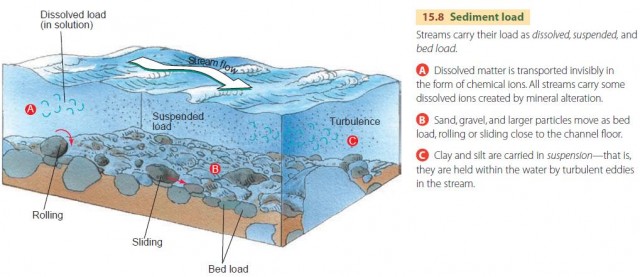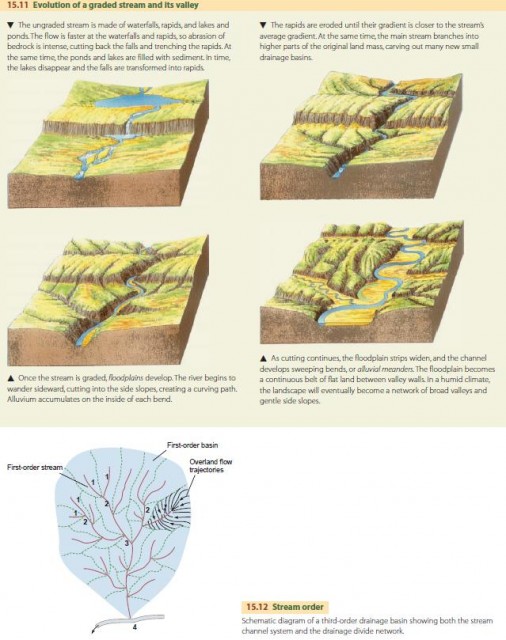The Work of Streams and Stream Gradation
Streams carry out three closely related activities—stream erosion, stream transportation, and stream deposition. Mineral materials, from bedrock or regolith, are removed from the floor and sides of the stream channel by erosion. The particles are suspended in the stream by turbulent water motion or are dissolved and held in solution. The transported particles are finally deposited on the streambed and floodplain, or on the floor of a standing body of water into which the stream empties, where they build up. Erosion, transportation, and deposition are simply three phases of a single activity.
STREAM EROSION
Streams erode in various ways, depending on the nature of the channel materials and the tools with which the current is armed. The flowing water drags on the bed and banks and also forces particles to hit the bed and banks. These actions easily erode alluvial materials, such as gravel, sand, silt, and clay. This form of erosion is called hydraulic action, and it can excavate enormous quantities in a short time when river flow is high. As the banks are undermined, large masses of alluvium slump into the river, where the particles are quickly separated and become part of the stream's load.
Where rock fragments carried by the swift current strike against bedrock channel walls, they knock off chips of rock. The larger, stronger fragments become rounded as they travel. As cobbles and boulders roll over the streambed, they crush and grind the smaller grains, producing a wide assortment of grain sizes. This process of mechanical wear is called abrasion. In bedrock that's too strong to be eroded by simple hydraulic action, abrasion is the main method of erosion. A striking example of abrasion is the erosion of a pothole.
Finally, chemical weathering removes rock from the stream channel. This is called corrosion. We see corrosion in limestone, in particular, which develops cupped and fluted surfaces.
STREAM TRANSPORTATION
The solid matter carried by a stream is the stream load. Figure 15.8 illustrates how stream load is carried in three ways—dissolved load, suspended load, or bed load. Of the three forms, suspended load is generally the largest. A large river such as the Mississippi, for example, carries as much as 90 percent of its load in suspension.
Stream capacity measures the maximum solid load of debris—including bed load and suspended load—that can be carried by a stream at a given discharge. It's given in units of tons per day passing downstream at a given location.

Stream capacity increases sharply as stream velo city rises. This is because swifter currents are more turbulent, so they can hold more sediment in suspension. The capacity to move bed load also increases with velocity because faster water drags against the bed harder. In fact, the capacity to move bed load increases according to the third to fourth power of the velocity. In other words, if a stream's velocity is doubled in times of flood, its ability to transport bed load will increase from 8 to 16 times. So, most of the conspicuous changes in a stream channel occur in a flood.
When waterflow increases, a stream flowing in a silt, sand, or gravel channel will easily widen and deepen that channel. When the flow slackens, the stream will deposit material in the bed, filling the channel again. If the stream flows in a hard bedrock channel, it won't be able to deepen the channel as quickly in response to rising waters, so it may not change much during a single flood. Such conditions exist in streams in deep canyons with steep gradients.
STREAM GRADATION
Most major stream systems have gone through thousands of years of runoff, erosion, and deposition. Over time, the gradients of different parts of the stream adjust so that they just carry the average load of sediment that they receive from slopes and inflowing channels. A stream in this condition is called a graded stream. How does this come about?
Visualize a small stream basin in which runoff and overland flow carry sediment to a stream channel. If more sediment accumulates each year in the stream channel than can be carried away, the surface of the channel will be built up and the slope of the stream will increase. But with increased slope comes increased stream velocity and increased ability to carry sediment. Eventually, the slope will reach a point at which the stream just carries away the sediment that it receives. If sediment flow to the stream is reduced, the stream will gradually erode its channel downward. This will reduce its slope and also reduce its ability to carry sediment until it can only carry the reduced amount it receives from the hillslopes.
Since every stream channel experiences this process, eventually the whole stream will tend toward a state in which the slopes of all its segments form a coordinated network that just carries the sediment load contributed by the drainage basin. A stream in this equilibrium condition is referred to as a graded stream.
Figure 15.10 shows how a graded stream might develop on a landscape that is rapidly uplifted, perhaps by a series of fault steps or blocks, or possibly uncovered after erosion by continental glaciers. The side of the block shows a series of stream profiles—plots of elevation of the stream with distance from the sea. At first, the stream is ungraded, with large fluctuations in the slope profile. As the stream cuts down, steeper areas are eroded more rapidly, smoothing the profile. Soon the stream has a graded profile, and the slope of each part is just sufficient to carry the average annual load of water and sediment produced by its drainage basin.

LANDSCAPE EVOLUTION OF A GRADED STREAM
Figure 15.11 shows how the stream gradation process over a landscape creates a floodplain and alluvial meanders over time. At first, downcutting produces canyons and gorges. With time, the stream becomes graded and begins to build a floodplain. The river moves freely from one side of the valley to the other in alluvial meanders that sweep down the valley. As the floodplain widens, the river attacks and undermines the adjacent valley wall less frequently. Weathering, mass wasting, and overland flow then act to reduce the steepness of the valley-side slopes. Eventually, a landscape of open valleys with soil-covered slopes forms, protected by a dense plant cover. It takes tens of millions of years for a stream to reach a graded condition and erode a broad valley.

STREAM ORDER
In a channel network, the gradient and channel form varies from the smaller, steeper streams at the headwaters of the network to the broad and gently sloping river channels found farther downstream. One way to study how the properties of streams change systematically is to organize them by stream order (Figure 15.12). The smallest tributaries are first-order streams, which receive overland flow from within their first-order basin. When two first-order streams join, the result is a second-order stream and so forth. As you might well imagine, many stream properties are related to stream order, including slope, drainage area, and discharge.